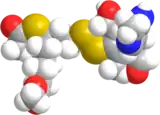Octotiamine
 | |
 | |
| Clinical data | |
|---|---|
| ATC code |
|
| Identifiers | |
IUPAC name
| |
| CAS Number | |
| PubChem CID | |
| ChemSpider | |
| UNII | |
| CompTox Dashboard (EPA) | |
| Chemical and physical data | |
| Formula | C23H36N4O5S3 |
| Molar mass | 544.74 g·mol−1 |
| 3D model (JSmol) | |
SMILES
| |
InChI
| |
Octotiamine (INN, JAN; Gerostop, Neuvita, Neuvitan), also known as thioctothiamine, is an analogue of vitamin B1 which is used in Japan and Finland.[1][2]
See also
- Vitamin B1 analogue
References
- ↑ Ganellin CR, Triggle DJ (21 November 1996). Dictionary of Pharmacological Agents. CRC Press. pp. 1469–. ISBN 978-0-412-46630-4.
- ↑ Index Nominum 2000: International Drug Directory. Taylor & Francis. January 2000. pp. 756–. ISBN 978-3-88763-075-1.
This article is issued from Offline. The text is licensed under Creative Commons - Attribution - Sharealike. Additional terms may apply for the media files.